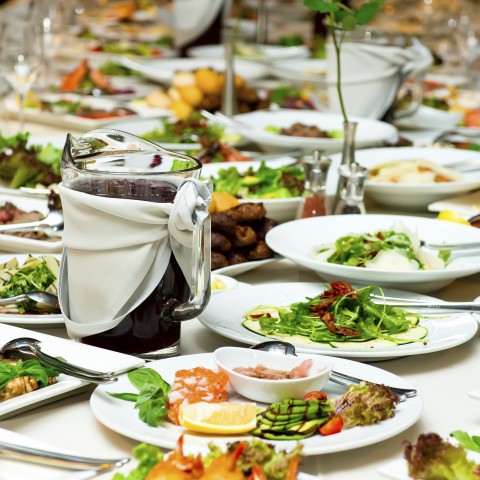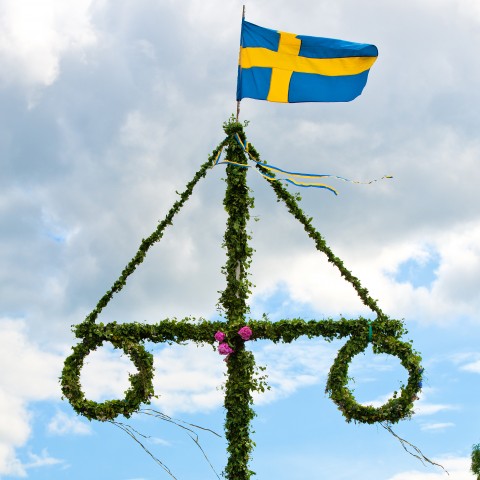You’re learning to speak Swedish, and it’s going well. Your confidence is growing! So much so that you feel ready to share your experiences on social media—in Swedish.
At Learn Swedish, we make this easy for you to get it right the first time. Post like a boss with these phrases and guidelines, and get to practice your Swedish in the process.

1. Talking about Your Restaurant Visit in Swedish
Eating out is fun, and often an experience you’d want to share. Take a pic, and start a conversation on social media in Swedish. Your friend will be amazed by your language skills…and perhaps your taste in restaurants!
Anders eats at a restaurant with his friends, posts an image of it, and leaves this comment:
POST
Let’s break down Anders’s post.
Äntligen fredag! Testar Slussen’s nya restaurang!
“Finally Friday! Trying out Slussen’s new restaurant!”
1- Äntligen fredag!
First is an expression meaning “Finally Friday!.”
An expression that is frequently used in Swedish, implying that the weekend is just around the corner, since Swedish people mostly work Mon-Fri.
2- Testar Slussen’s nya restaurang.
Then comes the phrase – “Trying out Slussen’s new restaurant. .”
“Testar” means to try out, and is often used when someone tries something for the first time. For example, a restaurant, a product or an activity. “Slussen” is the name of an area in Stockholm.
COMMENTS
In response, Anders’ friends leave some comments.
1- Smaklig måltid!
His girlfriend, Amanda, uses an expression meaning – “Have a nice meal!”
Use this expression to show you want your friend to have a good time.
2- Njut!
His neighbor, Caroline, uses an expression meaning – “Enjoy!”
Use this expression to show you are feeling warm-hearted.
3- Åh, vad avis jag är! Jobbar hela helgen!
His high school friend, Molly, uses an expression meaning – “Oh, I’m so jealous! Working all weekend!”
Use this expression to express that you wish you could be there too.
4- Hört att det är lite på den dyra sidan.
His girlfriend’s nephew, Alex, uses an expression meaning – “I’ve heard that it’s a bit on the expensive side. ”
Use this expression to show you are worried about the pricing of the food. This doesn’t have to be a cynical or negative comment; it’s just an observation. But take care not to post too many comments that could put out someone’s positivity!
VOCABULARY
Find below the key vocabulary for this lesson:
So, let’s practice a bit. If a friend posted something about having dinner with friends, which phrase would you use?
Now go visit a Swedish restaurant, and wow the staff with your language skills!
2. Post about Your Mall Visit in Swedish
Another super topic for social media is shopping—everybody does it, most people love it, and your friends on social media are probably curious about your shopping sprees! Share these Swedish phrases in posts when you visit a mall.
Amanda shops with her sister at the mall, posts an image of it, and leaves this comment:
POST
Let’s break down Amanda’s post.
Hittade snyggaste brillorna i stan!
“Found the nicest glasses in town!”
1- Hittade snyggaste brillorna…
First is an expression meaning “Found the nicest glasses….”
Brillor’ is slang for ‘glasses’ or ‘sunglasses’. The phrase “Hittade snyggaste …” can be used in a lot of different contexts.
2- … i stan!
Then comes the phrase – “… in town!.”
…i stan’ is a phrase that is added at the end of a sentence, such as ‘bästa restaurangen i stan’, meaning ‘the best restaurant in town’.
COMMENTS
In response, Amanda’s friends leave some comments.
1- Har inte du redan typ tio par…?
Her boyfriend, Anders, uses an expression meaning – “Don’t you already have like ten pairs…?”
Use this expression to show you are questioning if the person needs any more. It can also be somewhat humorous.
2- Snygging!
Her neighbor, Caroline, uses an expression meaning – “Hottie!”
Use this expression to compliment someone on their looks.
3- Ser bra ut!
Her high school friend, Molly, uses an expression meaning – “Looking good!”
Use this casual expression to note that someone looks good.
4- Sommaren är väl slut snart?
Her nephew, Alex, uses an expression meaning – “Isn’t summer over soon?”
This questions the wisdom of the purchase. A valid comment, but unless the poster is feeling humorous and teasing the poster, this could come across as a negative and critisizing comment.
VOCABULARY
Find below the key vocabulary for this lesson:
So, if a friend posted something about going shopping, which phrase would you use?
3. Talking about a Sport Day in Swedish
Sports events, whether you’re the spectator or the sports person, offer fantastic opportunities for great social media posts. Learn some handy phrases and vocabulary to start a sport-on-the-beach conversation in Swedish.
Anders plays with his friends at the beach, posts an image of it, and leaves this comment:
POST
Let’s break down Anders’s post.
“Here we go! Blue versus red, come on!”
1- Nu kör vi!
First is an expression meaning “Here we go!.”
“Kör” actually means drive, but in the expression “Nu kör vi” or “nu kör jag,” it means “here we go”, or “here I go”. It’s usually said in situations where a person is about to take a risk or attempt something. For example, a sports game, testing out something new, cleaning out the house, etc.
2- Kom igen!
Then comes the phrase – “Come on!.”
Kom igen! is similar to the English phrase “Come on!”. This phrase is used when cheering someone up, or cheering for someone, but it can also be used sarcastically like the English “Come on!”
COMMENTS
In response, Anders’s friends leave some comments.
1- Nu kör vi! Blå mot röd, kom igen!
His girlfriend, Amanda, uses an expression meaning – “You’re not forgetting dinner tonight, right?”
Use this expression to show you are feeling like the person may have forgotten previously-made plans.
2- Du låter taggad!
His neighbor, Caroline, uses an expression meaning – “You sound psyched!”
Use this expression to show you are being supportive.
3- Vi vill se bilder!
His high school friend, Molly, uses an expression meaning – “We want to see pictures!”
Use this expression to show that you are engaged in what’s happening.
4- Ha så kul men trampa inte på glas!
His girlfriend’s nephew, Alex, uses an expression meaning – “Have fun, but don’t step on glass!”
This is a well-wish, with an expression of concern about the poster’s wellbeing.
VOCABULARY
Find below the key vocabulary for this lesson:
Which phrase would you use if a friend posted something about sports?
But sport is not the only thing you can play! Play some music, and share it on social media.
4. Share a Song on Social Media in Swedish
Music is the language of the soul, they say. So, don’t hold back—share what touches your soul with your friends!
Amanda shares a song she just heard at a party, posts an image of the artist, and leaves this comment:
POST
Let’s break down Amanda’s post.
Kan inte sluta lyssna på Rihannas nya låt! Älska!
“Can’t stop listening to Rihanna’s new song! Love!”
1- Kan inte sluta…
First is an expression meaning “Can’t stop….”
This is a common expression on social media. It just means that the person cannot stop doing something. For example: “I can’t stop eating chocolate”, or “I can’t stop listening to this song”.
2- Älska!
Then comes the phrase – “Love!.”
Älska is used to express your love or strong feelings for something. It’s used very similar to Facebook’s “Like” button. Instead of a long sentence explaining that you like or love something, you just write “Älska” on social media.
COMMENTS
In response, Amanda’s friends leave some comments.
1- Jag vet… Kan texten utantill nu älskling…
Her boyfriend, Anders, uses an expression meaning – “I know… I know the lyrics by heart now, honey.”
Use this expression to show you are want to show that you are aware of the information, but in a nice way.
2- Åh, den är skitbra!
Her neighbor, Caroline, uses an expression meaning – “Oh, it’s awesome!”
Use this expression to show you are feeling supportive and appreciative of whatever what was posted.
3- Har du hört hennes låt Stay?
Her high school friend, Molly, uses an expression meaning – “Have you heard her song ‘Stay’?”
Use this expression to partake in the conversation.
4- Den är ju fett gammal nu ju.
Her nephew, Alex, uses an expression meaning – “That’s so old now!”
A criticism of the poster’s choice in music – unless you know each other well, and can joke around using sarcasm, you won’t be making yourself popular with comments like this.
VOCABULARY
Find below the key vocabulary for this lesson:
Which song would you share? And what would you say to a friend who posted something about sharing music or videos?
Now you know how to start a conversation about a song or a video on social media!
5. Swedish Social Media Comments about a Concert
Still on the theme of music—visiting live concerts and shows just has to be shared with your friends. Here are some handy phrases and vocab to wow your followers in Swedish!
Anders goes to a concert, posts an image of it, and leaves this comment:
POST
Let’s break down Anders’s post.
Köat fyra timmar men snart är det dax! Kan knappt vänta!
“Queued for four hours, but it’s almost time! Can barely wait!”
1- Snart är det dax!
First is an expression meaning “It’s almost time!.”
Snart äre dax! — “äre” is short for “är det” meaning “is it” or “it is”. And “dax” is slang for “dags” meaning “time”. So the expression means “it’s almost time.” It can be used independently or as part of a longer sentence. For example: “Det är snart dax för helg”, which means “It’s almost time for the weekend.”
2- Kan knappt vänta!
Then comes the phrase – “Can barely wait!.”
An expression that is used when someone is excited about something. Can be used independently or as part of a longer sentence. For example: “Kan knappt vänta till semestern”, which means: “Can barely wait till the holidays!”
COMMENTS
In response, Anders’s friends leave some comments.
1- Ha kul, du förtjänar det!
His girlfriend, Amanda, uses an expression meaning – “Have fun, you deserve it!”
Use this expression to show you are feeling supportive and warm-hearted.
2- Vad äre för konsert?
His neighbor, Caroline, uses an expression meaning – “What kind of concert is it?”
Use this expression to show you are interested in the topic and want to know more.
3- Akta dig för moshpiten!
His college friend, Elias, uses an expression meaning – “Watch out for the mosh pit!”
Use this expression to show you are feeling playful. “Moshing” or “slamdancing”, according to Wikipedia:”… is a style of dance in which participants push or slam into each other, typically performed in “aggressive” live music. Moshing usually happens in the center of the crowd, generally closer to the stage, in an area called the “pit”.” It is a very energetic spot, with lots of full-body contact.
4- Palla köa i fyra timmar!
His girlfriend’s nephew, Alex, uses an expression meaning – “How can you queue for four hours?!”
Again, a question criticising the poster’s wisdom. You can get away with this if you know the poster very well, or you might become known as the “wet rag”, or “spoil sport”!
VOCABULARY
Find below the key vocabulary for this lesson:
If a friend posted something about a concert, which phrase would you use?
6. Talking about an Unfortunate Accident in Swedish
Oh dear. You broke something by accident. Use these Swedish phrases to start a thread on social media. Or maybe just to let your friends know why you are not contacting them!
Amanda accidentally breaks her mobile phone, and leaves this comment:
POST
Let’s break down Amanda’s post.
Tappade luren i golvet. Vet någon var jag kan laga en iPhone skärm billigt?
“Dropped my phone on the floor. Does anyone know where I can fix an iPhone screen cheaply?”
1- Tappade luren i golvet.
First is an expression meaning “Dropped my phone on the floor. .”
“lur” is slang for phone and is commonly used in Sweden. Unfortunately people drop their phones a lot, so you may hear “tappade” (dropped) “luren” or “telefonen” (the phone) “i golvet” (on the floor) often.
2- Vet någon var jag kan laga en Iphone skärm billigt?
Then comes the phrase – “Does anyone know where I can fix an iPhone screen cheaply?”
“Vet någon” is a good way of asking a question. It means “Does anyone know?”. “Laga” in this sentence means “to fix” or “to repair”, but in other contexts, it can also mean “to cook”. This is similar to English, when we say: “I’ll fix us something for supper”, for instance, and also: “Have your cell-phone fixed”.
COMMENTS
In response, Amanda’s friends leave some comments.
1- Älskling, inte igen!
Her boyfriend, Anders, uses an expression meaning – “Honey, not again!”
Use this expression to show you are feeling disappointed.
2- Åh neeej, hatar när det händer!
Her neighbor, Caroline, uses an expression meaning – “Oh nooo, hate when that happens!”
Use this expression to show you are feeling empathic and caring.
3- Äsch, kanske dags att skaffa en ny?
Her high school friend, Molly, uses an expression meaning – “Well, maybe it’s time to get a new one?”
Use this expression to be humorous, and a bit sarcastic.
4- Har du drulleförsäkring på den?
Her nephew, Alex, uses an expression meaning – “Do you have accident insurance on it? ”
Use this expression to show you are practical, even concerned.
VOCABULARY
Find below the key vocabulary for this lesson:
If a friend posted something about having broken something by accident, which phrase would you use?
So, now you know how to discuss an accident in Swedish. Well done!
7. Chat about Your Boredom on Social Media in Swedish
Sometimes, we’re just bored with how life goes. And to alleviate the boredom, we write about it on social media. Add some excitement to your posts by addressing your friends and followers in Swedish!
Anders gets bored at home, and leaves this comment:
POST
Let’s break down Anders’s post.
Vilken seg dag! Uttråkad, några tips?
“What a slow day! Bored. Any tips?”
1- Vilken seg dag!
First is an expression meaning “What a slow day!.”
A common phrase used in Sweden when people feel like time is passing slowly. For example: “Vilken seg arbetsdag!” (“What a slow workday!” ) It can also be used when describing people. For example: “Erik, kan du sluta vara så seg?”, which means: “Erik, can you stop being so slow?”
2- Uttråkad, några tips?
Then comes the phrase – “Bored, any tips?.”
On social media we tend to express ourselves in shorter phrases than we would when speaking. “Uttråkad, några tips?” is a good example. You can change the phrase to any topic you would like to get tips or advice about. For example: “Hungrig, några tips?”, which means: “Hungry, any tips?”
COMMENTS
In response, Anders’s friends leave some comments.
1- Du kanske vill städa golven innan jag kommer hem?
His girlfriend, Amanda, uses an expression meaning – “Maybe you’d like to clean the floors before I get home?”
Use this expression if you feel humorous and are teasing the poster. Rather not give serious instructions about householding on social media to your beloved!
2- Vill du ta en fika vid lunch?
His neighbor, Caroline, uses an expression meaning – “Do you want to go for a coffee around lunch time?”
This is an invitation to alleviate the poster’s boredom. It’s friendly and caring.
3- Jag med! Less på att vara arbetslös nu.
His girlfriend’s nephew, Alex, uses an expression meaning – “Me too! Fed up with being unemployed right now.”
Use this expression to show you are feeling cynical.
4- Gör som alla andra, glo på YouTube videos haha!
His high school friend, Molly, uses an expression meaning – “Do what everyone else does. Watch YouTube videos haha!”
Use this expression to be humorous while also making a suggestion.
VOCABULARY
Find below the key vocabulary for this lesson:
If a friend posted something about being bored, which phrase would you use?
Still bored? Share another feeling and see if you can start a conversation!
8. Exhausted? Share It on Social Media in Swedish
Sitting in public transport after work, feeling like chatting online? Well, converse in Swedish about how you feel, and let your friends join in!
Amanda feels exhausted after a long day at work, posts an image of herself looking tired, and leaves this comment:
POST
Let’s break down Amanda’s post.
Åh, så trött att jag tror jag avlider!
“Oh, I’m so tired, I think I’ll die!”
1- Så trött
First is an expression meaning “So tired.”
In English we use the word “so” to make it clear how strongly we feel about something. For example: “I’m so tired!” In Swedish we use “så” in the same way. For example: “Jag är så hungrig!” which means
‘I’m so hungry!” Or: “Jag fryser så mycket!” which means, “I’m so cold!”
2- att jag tror att jag avlider.
Then comes the phrase – “that I think I’ll die..”
We often use the phrase “att jag tror att jag avlider,” meaning “that I think I’ll die.” A common expression is: “Jag fryser så mycket att jag tror att jag avlider”, which means “I’m so cold I think I’m going to die.” We also use “att jag tror att jag dör”, meaning the exact same thing. For example: “Jag är så trött att jag tror att jag dör!” which means “I’m so tired, I think I’ll die!”
COMMENTS
In response, Amanda’s friends leave some comments.
1- Skynda dig hem, nu är det filmkväll och mys!
Her boyfriend, Anders, uses an expression meaning – “Hurry home. It’s movie night and cuddles now!”
Use this expression to show you are feeling loving and supportive.
2- Vad är det som har hänt?
Her neighbor, Caroline, uses an expression meaning – “What happened?”
Use this expression to show you are feeling warm-hearted and caring.
3- Nej, dö inte!!
Her high school friend, Molly, uses an expression meaning – “No, don’t die!!”
Use this expression when you feel humorous.
.
4- Varför? Vad händer?
Her college friend, Elias, uses an expression meaning – “Why? What’s happening?”
Use this expression to show you want to know what’s going on.
VOCABULARY
Find below the key vocabulary for this lesson:
If a friend posted something about being exhausted, which phrase would you use?
Now you know how to say you’re exhausted in Swedish! Well done.
9. Talking about an Injury in Swedish
So life happens, and you manage to hurt yourself during a soccer game. Very Tweet-worthy! Here’s how to do it in Swedish.
Anders suffers a painful injury, posts an image of it, and leaves this comment:
POST
Let’s break down Anders’s post.
Hej på dig sjukskrivning, nu är det dags att vara sängliggandes ett tag då.
“Hello, sick leave. It’s time to be bedridden for a while now.”
1- Hej på dig sjukskrivning
First is an expression meaning “Hello to you sick leave.”
“Hej på dig” is a phrase commonly used when greeting people, but in Sweden we can also greet an object or an event, and not always with a positive spirit. “Hej på dig” can be shortened to just “Hej”.
2- nu är det dags att vara sängliggandes ett tag då.
Then comes the phrase – “it’s time to be bedridden for a while now then..”
“Nu är det att” means “now it’s time to…” This phrase can be used for anything that is about to happen, such as going somewhere or doing something. For example: “Nu är det middagsdags då!”, which means “It’s dinner time now!”
COMMENTS
In response, Anders’s friends leave some comments.
1- Tur i oturen, nu kanske du får lite vila i alla fall!
His neighbor, Caroline, uses an expression meaning – “Blessing in disguise. At least you might get some rest now!”
Use this phrase when you are feeling warm-hearted and are trying to cheer someone up. .
2- Så illa är det inte, det är bara en stukning.
His girlfriend, Amanda, uses an expression meaning – “It’s not that bad. It’s just a sprain.”
This type of post is probably intended to inform and reassure the other posters. Otherwise, it could sound like you’re making light of the poster’s discomfort.
3- Lever du? Ska jag komma över med glass och soppa?
His high school friend, Molly, uses an expression meaning – “Are you alive? Should I come over with ice cream and soup?”
Use this expression to be funny and light-hearted.
4- Du är för gammal för att klättra på taket vet du väl!
His girlfriend’s nephew, Alex, uses an expression meaning – “You’re too old to be climbing the roof, you know!”
Use this expression to be a bit sarcastic and humorous simultaneously.
VOCABULARY
Find below the key vocabulary for this lesson:
If a friend posted something about being injured, which phrase would you use?
We love to share our fortunes and misfortunes; somehow that makes us feel connected to others.
10. Starting a Conversation Feeling Disappointed in Swedish
Sometimes things don’t go the way we planned. Share your disappointment about this with your friends!
Amanda feels disappointed about today’s weather, posts an image of it, and leaves this comment:
POST
Let’s break down Amanda’s post.
Jag såg fram emot att tillbringa min lediga dag på stranden, men självklart ska det regna!
“I was looking forward to spending my day off on the beach, but of course it had to rain!”
1- Jag såg fram emot…
First is an expression meaning “I was looking forward to….”
This phrase is used when expressing disappointment over ruined or cancelled plans. For example: “Jag såg fram emot att gå ut och äta…” which means “I was looking forward to going out to eat.” This phrase is usually followed by “men,” meaning “but,” and the reason why the plans were ruined or cancelled.
2- Men självklart ska…
Then comes the phrase – “But of course it had to….”
This is the second half of the expression. Jag såg fram emot …. men självklart ska det… “I was looking forward to …. but of course it had to…” For example: “Jag såg fram emot en shoppingdag men självklart ska plånboken bli stulen”. “I was looking forward to a day of shopping, but of course my wallet had to get stolen.”
COMMENTS
In response, Amanda’s friends leave some comments.
1- Vad sägs som att äta lunch ute?
Her boyfriend, Anders, uses an expression meaning – “What do you say about going out for lunch?”
Use this expression when you are inviting someone out. “Lunch” can of course be substituted with other nouns.
2- Åh nej, vad synd!
Her neighbor, Caroline, uses an expression meaning – “Oh no, what a shame!”
Use this expression to show you are feeling warm-hearted and caring.
3- Vi får göra det bästa av situationen ändå!
Her college friend, Elias, uses an expression meaning – “We’ll make the best of it.”
Use this expression to show you are feeling optimistic and encouraging.
4- Den här sommaren är ovanligt regnig.
Her nephew, Alex, uses an expression meaning – “This summer’s unusually rainy. ”
This is a comment about the weather. In this particular context, it’s in agreement with the poster.
VOCABULARY
Find below the key vocabulary for this lesson:
How would you comment in Swedish when a friend is disappointed?
Not all posts need to be about a negative feeling, though!
11. Talking about Your Relationship Status in Swedish
Don’t just change your relationship status in Settings, talk about it!
Anders changes his status to “In a relationship”, posts an image of it, and leaves this comment:
POST
Let’s break down Anders’s post.
Då var det dags att göra det officiellt!
“It’s time to make it official!”
1- Då var det dags…
First is an expression meaning “It’s time….”
This expression is used when explaining that it’s time for something, usually a change. For example: “Då var det dags att söka nytt jobb!” which means “It’s time to look for a new job!”
2- att göra det officiellt!
Then comes the phrase – “to make it official!.”
“…att göra det officiellt” is an expression that is used when declaring news or a change. It can be either informal or formal. Another commonly used expression is “Nu är det officiellt” which means “It’s official now”.
COMMENTS
In response, Anders’ friends leave some comments.
1- Du gör mig så lycklig!
His girlfriend, Amanda, uses an expression meaning – “You make me so happy!”
Use this expression to show you are feeling appreciative and loving.
2- Slut på ungkarlsdagarna?
His neighbor, Caroline, uses an expression meaning – “Bachelor days are over?”
Use this expression when you feel humorous but in a warm-hearted way.
3- Det var på tiden!
His supervisor, Oliver, uses an expression meaning – “About time!”
This is a comment that shows something has been coming or in the making for a while – probably too long!
4- Själv är man fortfarande singel.
His girlfriend’s nephew, Alex, uses an expression meaning – “I’m still single. ”
This is a bit of personal information about a relationship status that could fuel the conversation nicely.
VOCABULARY
Find below the key vocabulary for this lesson:
What would you say in Swedish when a friend changes their relationship status?
Being in a good relationship with someone special is good news – don’t be shy to spread it!
12. Post about Getting Married in Swedish
Wow, so things got serious, and you’re getting married. Congratulations! Or, your friend is getting married, so talk about this in Swedish.
Amanda is getting married today, so she leaves this comment:
POST
Let’s break down Amanda’s post.
Det här är den bästa dagen i mitt liv!
“This is the best day of my life!”
1- Det här är den bästa dagen…
First is an expression meaning “This is the best day….”
This expression is used to express the superlative form of something. For example: “Det här är den värsta lägenheten…” which means “This is the worst apartment…”
2- … i mitt liv!
Then comes the phrase – “… of my life!.”
This can be added on to the superlative expression. For example: “Det här är den värsta lägenheten jag sett i mitt liv”, which means “This is the worst apartment I’ve seen in my life.” It expresses that within your lifetime, this is the worst you have experienced.
COMMENTS
In response, Amanda’s friends leave some comments.
1- Du och jag mot världen!
Her husband, Anders, uses an expression meaning – “You and me against the world!”
Use this expression when you are being supportive and loving.
2- Nu ska vi fira!
Her neighbor, Caroline, uses an expression meaning – “Now, let’s celebrate!”
Use this expression to show you are feeling enthusiastic and optimistic.
3- Jag kommer gråta och se ut som en tvättbjörn!
Her high school friend, Molly, uses an expression meaning – “I’m going to cry, and I’ll look like a raccoon!”
Use this expression when you’re feeling emotional, and try to hide it by being funny.
4- Jag tror inte på giftermål…
Her nephew, Alex, uses an expression meaning – “I don’t believe in marriage…”
Use this expression to show you are feeling cynical.
VOCABULARY
Find below the key vocabulary for this lesson:
How would you respond in Swedish to a friend’s post about getting married?
For the next topic, fast forward about a year into the future after the marriage…
13. Announcing Big News in Swedish
Wow, huge stuff is happening in your life! Announce it in Swedish.
Anders finds out he and his wife are going to have a baby, posts an image of it, and leaves this comment:
POST
Let’s break down Anders’ post.
Idag fick jag veta att jag ska bli pappa! Vilken stolthet jag känner!
“Today, I found out that I’m going to be a dad! I feel so proud!”
1- Idag fick jag veta att jag ska bli pappa!
First is an expression meaning “Today, I found out that I’m going to be a dad!”
“Idag fick jag veta”, meaning “Today I found out”, is a good way to start a sentence when proclaiming news. “idag” (today) can be substituted for “den här veckan” (this week) or another time frame.
2- Vilken stolthet jag känner!
Then comes the phrase – “The pride I feel!”
Vilken stolthet jag känner! is a strong expression to use when you are so proud that you can barely contain it. “Stolthet” (pride) can be substituted for other emotions such as “sorg” (sadness) or “lycka” (happiness).
COMMENTS
In response, Anders’ friends leave some comments.
1- Vi vet inte om det är en pojke eller flicka ännu.
His wife, Amanda, uses an expression meaning – “We don’t know if it’s a boy or a girl yet.”
This expression explains that you don’t know the gender of your baby yet.
2- Har ni funderat på namn ännu?
His neighbor, Caroline, uses an expression meaning – “Have you thought about names yet?”
Use this phrase if you want to know more information.
3- Tvillingar?
His supervisor, Oliver, uses an expression meaning – “Twins?”
With this word, you’re also indicating that you want more information about the baby.
4- Vänta tills ni köper barnvagn, det är så jäkla dyrt!
His nephew, Alex, uses an expression meaning – “Wait until you buy a stroller, it’s so expensive!”
This is a cynical expression that can be just about sharing information, or it can be a real downer.
VOCABULARY
Find below the key vocabulary for this lesson:
Which phrase would you choose when a friend announces their pregnancy on social media?
So, talking about a pregnancy will get you a lot of traction on social media. But wait till you see the responses to babies!
14. Posting Swedish Comments about Your Baby
Your bundle of joy is here, and you cannot keep quiet about it! Share your thoughts in Swedish.
Amanda plays with her baby, posts an image of it, and leaves this comment:
POST
Let’s break down Amanda’s post.
Kan knappt tro att den här gullungen är min! Alltså, titta på leendet!
“I can barely believe this sweet kid is mine! I mean, look at that smile!”
1- Kan knappt tro att den här gullungen är min!
First is an expression meaning “Can barely believe this sweet kid is mine!.”
“Kan knappt tro” means “I can barely believe,” and it’s used when expressing something unbelievable, shocking or surprising. For example: “Jag kan knappt tro att det är sant!” (“I can barely believe it’s true!” )
2- Alltså, titta på leendet!
Then comes the phrase – “I mean, look at that smile!.”
“Alltså” is slang and can be translated to many English words, such as well, therefore, and so. “Alltså” is used to fill out a sentence, but is not actually needed. It does not change the meaning of the sentence, but it can change the feeling or attitude. For example: “Alltså, titta vad dyrt!” (“I mean, look how expensive!” ). Or without “alltså” – “Titta vad dyrt!” (“Look, how expensive!” ).
COMMENTS
In response, Amanda’s friends leave some comments.
1- Hon brås på sin farsa minsann!
Her husband, Anders, uses an expression meaning – “She takes after her dad, indeed!”
Use this expression to show you are being boastful and proud.
2- Finis!
Her neighbor, Caroline, uses an expression meaning – “Gorgeous!”
Use this expression to show you are feeling enthusiastic and appreciative.
3- Hon ser ju ut som dig när du var liten!
Her high school friend, Molly, uses an expression meaning – “She looks like you when you were a kid!”
Use this expression to be funny and sweet.
4- De växer ju så det knakar!
Her nephew, Alex, uses an expression meaning – “They grow so quickly!”
Use this expression to show you are feeling practical and maybe a bit cynical, in this particular context.
VOCABULARY
Find below the key vocabulary for this lesson:
If your friend is the mother or father, which phrase would you use on social media?
Congratulations, you know the basics of chatting about a baby in Swedish! But we’re not done with families yet…
15. Swedish Comments about a Family Reunion
Family reunions – some you love, some you hate. Share about it on your feed.
Anders goes to a family gathering, posts an image of it, and leaves this comment:
POST
Let’s break down Anders’ post.
Alla vet ju att släkten är värst, varför måste vi då gå på familjemiddag?!
“Everyone knows that family is the worst, so why do we have to go to family dinners then?!”
1- Alla vet ju att släkten är värst
First is an expression meaning “Everyone knows that family is the worst.”
“Alla vet ju” is a common expression meaning “Everyone knows”. It’s used when speaking to a group of people, where most of those people “know” something. It’s an expression used to exaggerate. “Vet” (know) can be substituted for another verb. For example: “Alla har ju iPhones” (Everyone has iPhones), but this is an exaggeration commonly used in most languages, because not every person in the world owns an iPhone!
2- varför måste vi då gå på familjemiddag?!
Then comes the phrase – “so why do we have to go to family dinners then?”
“varför måste vi” (Why do we have to) is a common expression. You can substitute “vi” (we) for “jag” (I) or any other person. For example: “Varför måste jag städa mitt rum nu?” (“Why do I have to clean my room now?” )
COMMENTS
In response, Anders’ friends leave some comments.
1- Så illa kan det väl inte vara?
His neighbor, Caroline, uses an expression meaning – “It can’t be that bad?”
Use this expression to show you are feeling warm-hearted and concerned.
2- Smyg med dig en fickplunta, du vet ifall att…
His high school friend, Molly, uses an expression meaning – “Sneak a hip flask with you, just in case…”
Make this suggestion as a joke.
3- Om jag ska lida, så får du också lida. Det kallas kärlek.
His wife, Amanda, uses an expression meaning – “If I have to suffer, you have to suffer too. It’s called love. ”
This is an expression that shows a specific belief about love and relationships.
4- Var glad att du inte är spansk, jag har hört att de umgås med familjen varje helg!
His nephew, Alex, uses an expression meaning – “Be happy you’re not Spanish; I’ve heard they hang out with family every weekend!”
This is a humorous way to encourage someone to take heart cause things could’ve been worse.
VOCABULARY
Find below the key vocabulary for this lesson:
Which phrase is your favorite to comment on a friend’s photo about a family reunion?
16. Post about Your Travel Plans in Swedish
So, the family are going on holiday. Do you know how to post and leave comments in Swedish about being at the airport, waiting for a flight?
Amanda waits at the airport for her flight, posts an image of it, and leaves this comment:
POST
Let’s break down Amanda’s post.
Nu bär det av till Spanien! Nu sticker vi!
“We’re off to Spain! We’re taking off now!”
1- Nu bär det av till Spanien!
First is an expression meaning “Now we’re off to Spain!.”
“Nu bär det av till” is an expression used when you are about to depart. It’s most commonly used when leaving for a destination far away, such as another country or city.
2- Nu sticker vi!
Then comes the phrase – “We’re leaving now!.”
“att sticka” actually means “to sting”, but it’s also a slang expression meaning “we’re leaving”. “Nu sticker jag!” (I’m leaving now!)
COMMENTS
In response, Amanda’s friends leave some comments.
1- Farväl regniga Sverige! Sol och bad, här kommer vi!
Her husband, Anders, uses an expression meaning – “Farewell, rainy Sweden! Sun and sea, here we come!”
Use this expression to show you are feeling enthusiastic and excited.
2- Får man följa med?
Her neighbor, Caroline, uses an expression meaning – “Can I come?”
Use this expression to show you are feeling a bit envious and wants to join in the fun.
3- Håll hårt i pass och plånböcker!
Her nephew, Alex, uses an expression meaning – “Hold on to your passports and wallets!”
Use this expression to demonstrate your concern for the poster’s safety and possessions.
4- Kan ni smuggla med mig i resväskan eller?
Her high school friend, Molly, uses an expression meaning – “Can you smuggle me in your suitcase or what?”
Use this expression to be funny, also to demonstrate that you’re somewhat envious of the poster’s plans.
VOCABULARY
Find below the key vocabulary for this lesson:
Choose and memorize your best airport phrase in Swedish!
17. Posting about an Interesting Find in Swedish
So maybe you’re strolling around at your local market, and find something interesting. Here are some handy Swedish phrases!
Anders finds an unusual item at a local market, posts an image of it, and leaves this comment:
POST
Let’s break down Anders’ post.
Tala om för mig vad detta är! Jag har ingen aning!
“Tell me what this is! I have no idea!”
1- Tala om för mig vad detta är!
First is an expression meaning “Tell me what this is!”
“Tala om för mig” means “tell me” and is used when asking someone to explain something. It’s used informally and can be considered rude if used in a formal situation. If you want to use it in a polite way, you can add “Kan du” (Could you) before the phrase and “är du snäll” (please) after the phrase. För example: “Kan du tala om för mig hur jag tar mig till tågstationen är du snäll?” (“Could you tell me how I can get to the train station, please?” )
2- Jag har ingen aning!
Then comes the phrase – “I have no idea!.”
“Jag har ingen aning” is a phrase used by a person who really had no idea about the answer to a question, or what should be done in a certain situation. It’s a common expression among both children and adults.
COMMENTS
In response, Anders’ friends leave some comments.
1- Vad tusan är det där?
His college friend, Elias, uses an expression meaning – “What is that?”
Use this expression to show you are feeling confusion, same as the poster.
2- Har aldrig sett något liknande!
His neighbor, Caroline, uses an expression meaning – “I’ve never seen anything like it!”
Use this expression to show you are feeling surprised.
3- Lever man tillräckligt länge så får man se allt…
His wife, Amanda, uses an expression meaning – “If you live long enough, you get to see everything…”
Use this phrase to express something that means roughly the same as “There’s nothing new under the sun”.
4- Vad i??
His nephew, Alex, uses an expression meaning – “What the??”
Use this expression to show you are feeling great surprise
VOCABULARY
Find below the key vocabulary for this lesson:
Which phrase would you use to comment on a friend’s interesting find?
Perhaps you will even learn the identity of your find! Or perhaps you’re on holiday, and visiting interesting places…
18. Post about a Sightseeing Trip in Swedish
Let your friends know what you’re up to in Swedish, especially when visiting a remarkable place! Don’t forget the photo.
Amanda visits a famous landmark, posts an image of it, and leaves this comment:
POST
Let’s break down Amanda’s post.
Hur häftigt är inte detta? Jag står på toppen av Frihetsguddinnan!
“How cool is this? I’m standing at the top of the Statue of Liberty!”
1- Hur häftigt är inte detta?
First is an expression meaning “How cool is this?.”
This is used when expressing strong emotions over something. You’re not actually expecting an answer to your question. You can substitute “häftigt” (cool) for other adjectives such as “snyggt” (beautiful/cool), “dåligt” (bad), or “mysko” (weird). “Hur mysko är inte detta?” means “How weird is this?”
2- Jag står på toppen av Frihetsguddinnan!
Then comes the phrase – “I’m standing at the top of the Statue of Liberty!.”
“Jag står” means “I’m standing.” It can be changed to “Jag sitter” (“I’m sitting” ) or “Jag är” (“I am” ), and the location. For example: “Jag sitter på tåget”. (“I’m sitting on the train” ), or “Jag är på kryssningsfartyget nu”. (“I’m on the cruise ship now” ). It is an expression that’s used to tell people where you are and what you are doing.
COMMENTS
In response, Amanda’s friends leave some comments.
1- Tog du trapporna upp eller fuskade du och tog hissen?
Her neighbor, Caroline, uses an expression meaning – “Did you take the stairs up or did you cheat and take the elevator? ”
Use this expression to show you are feeling warm-hearted and making a joke.
2- Jag trodde Anders var höjdrädd?
Her supervisor, Oliver, uses an expression meaning – “I thought Anders was afraid of heights?”
Use this expression to be lightly teasing, or it can also be a serious question to clarify whether someone has a fear of heights.
3- Du är inte rädd för höjder, va?
Her nephew, Alex, uses an expression meaning – “You’re not afraid of heights, right? ”
With this phrase, you make a statement, but also wants confirmation of its accuracy.
4- Jag valde ju då att skippa detta…
Her husband, Anders, uses an expression meaning – “Well, I chose to skip this…”
This is sharing a report on your activities; in this case, you chose not to partake in an activity.
VOCABULARY
Find below the key vocabulary for this lesson:
Which phrase would you prefer when a friend posts about a famous landmark?
Share your special places with the world. Or simply post about your relaxing experiences.
19. Post about Relaxing Somewhere in Swedish
So you’re doing nothing yet you enjoy that too? Tell your social media friends about it in Swedish!
Anders relaxes at a beautiful place, posts an image of it, and leaves this comment:
POST
Let’s break down Anders’ post.
Det här är livet! En kall bira och solsken!
“This is life! A cold drink and sunshine!”
1- Det här är livet!
First is an expression meaning “This is life!.”
“Det här är livet!” is an expression used when life is really good. A variation of the expression is “Det här är det goda livet!” meaning “This is the good life!”
2- En kall bira och solsken!
Then comes the phrase – “A cold beer and sunshine!.”
“bira” is slang, meaning “öl” (beer). Most men consider a cold beer to be one of the best things in the world.
COMMENTS
In response, Anders’ friends leave some comments.
1- Najs! Du tänkte inte bjuda med mig?
His neighbor, Caroline, uses an expression meaning – “Nice! You weren’t going to invite me? ”
Use this expression to show you are feeling warmhearted but maybe also somewhat left out.
2- Du sparar en till mig också?
His wife, Amanda, uses an expression meaning – “You’ll save one for me too?”
Use this expression to show you want to be included.
3- Det var länge sen man hade en riktig slappdag.
His nephew, Alex, uses an expression meaning – “It’s been a long time since I had a real chill day.”
Use this expression to share that you haven’t had a nice, relaxing day for a long time.
4- Somliga jobbar ju hela dagen idag…
His supervisor, Oliver, uses an expression meaning – “Some people work all day today…”
Use this expression to be old fashioned and a bit sarcastic, in this context.
VOCABULARY
Find below the key vocabulary for this lesson:
Which phrase would you use to comment in a friend’s feed?
The break was great, but now it’s time to return home.
20. What to Say in Swedish When You’re Home Again
And you’re back! What will you share with friends and followers?
Amanda returns home after a vacation, posts an image of it, and leaves this comment:
POST
Let’s break down Amanda’s post.
Borta bra men hemma bäst! Helt rätt!
“Away is good, but home is best! Absolutely right!”
1- Borta bra men hemma bäst!
First is an expression meaning: “Away is good, but home is best!.”
This is a popular expression used in Swedish. It’s used to express that traveling is fun and good, but home is still the best place to be. This expression is often used when returning home after being away for some time.
2- Helt rätt!
Then comes the phrase – “Completely right!.”
This is an expression used when you completely agree with what someone says. Another expression that means the same thing is “Det stämmer”, which means “That’s correct.”
COMMENTS
In response, Amanda’s friends leave some comments.
1- Välkommen tillbaka!
Her supervisor, Oliver, uses an expression meaning – “Welcome back!”
Use this expression to be welcoming and kind.
2- Nä, själv tycker jag att gräset är grönare på andra sidan!
Her college friend, Elias, uses an expression meaning – “Nah, personally, I think the grass is greener on the other side!”
Use this expression to show you are feeling frivolous and humorous.
3- Men gumman, du var ju bara borta en vecka!
Her high school friend, Molly, uses an expression meaning – “But honey, you were only away for a week!”
Use this expression to be funny and caring.
4- Önskar jag också fick åka på semester!
Her friend, Anneli, uses an expression meaning – “Wish I could go on a holiday too!”
Use this expression when you want to express a wish about going away on holiday.
VOCABULARY
Find below the key vocabulary for this lesson:
How would you welcome a friend back from a trip?
What do you post on social media during a public holiday and festival, such as Midsummer Day?
21. It’s Time to Celebrate in Swedish
It’s a celebratory day and you wish to post something about it on social media. What would you say?
Anders attends Midsummer Festival celebrations, posts a photo of the events, and leaves this comment:
POST
Let’s break down Anders’ post.
Glad midsommar! Nu ska det firas!
“Happy Midsummer! It’s time to celebrate now!”
1- Glad midsommar!
First is an expression meaning “Happy Midsummer!.”
This Swedish expression is used on Midsummer eve to wish people a happy celebration. Midsummer is celebrated in June.
2- Nu ska det firas!
Then comes the phrase – “It’s time to celebrate now!.”
An expression used when it’s time to celebrate. It can be used on any holiday that is commonly celebrated.
COMMENTS
In response, Anders’ friends leave some comments.
1- Detta blir årets bästa middag!
His friend, Anneli, uses an expression meaning – “This will be the best dinner of the year!”
Use this expression to show you are excited about the event.
2- Skål på er allihopa!
His wife, Amanda, uses an expression meaning – “Cheers to all of you!”
Use this expression to show you are feeling kind and wish everyone well.
3- Nu blir det dans runt midsommarstången med barnen!
His neighbor, Caroline, uses an expression meaning – “Now it’s time to dance around the maypole with the kids!”
Use this expression to show you are feeling excited about the festivities taking place.
4- Kan knappt tro det, en midsommar utan regn!
His high school friend, Molly, uses an expression meaning – “(I) can hardly believe it; a midsummer without rain!”
Use this phrase to express amazement at the weather.
VOCABULARY
Find below the key vocabulary for this lesson:
If a friend posted something about a holiday, which phrase would you use?
Midsummer’s Day and other public commemoration days are not the only special ones to remember!
22. Posting about a Birthday on Social Media in Swedish
Your friend or you are celebrating your birthday in an unexpected way. Be sure to share this on social media!
Amanda goes to her birthday party, posts an image of it, and leaves this comment:
POST
Let’s break down Amanda’s post.
Tack för den fantastiska festen! Då var man ett år äldre då!
“Thank you for the fantastic party! I guess I’m one year older now!”
1- Tack för den fantastiska festen!
First is an expression meaning “Thank you for the fantastic party!.”
“Tack för” (Thank you for) is a phrase used when thanking people for something. For example: “den underbara middagen” (the wonderful dinner).
2- Då var man ett år äldre då!
Then comes the phrase – “I’m one year older now then!.”
This is a phrase often used jokingly by someone who’s just had their birthday, suggesting that they’ve aged. It’s said by middle-aged people the most and is commonly seen on birthday cards with jokes.
COMMENTS
In response, Amanda’s friends leave some comments.
1- Du ser inte en dag äldre ut!
Her husband, Anders, uses an expression meaning – “You don’t look a day older!”
Use this phrase to compliment someone on their youthful appearance, despite their age.
2- Man är bara så gammal som man känner sig!
Her high school friend, Molly, uses an expression meaning – “You’re only as old as you feel!”
This is a common saying that means just what it says – if you don’t feel old, you are not old! Comment like this simply to partake in the online conversation.
3- Ha den äran!
Her college friend, Elias, uses an expression meaning – “Happy birthday!”
Use this traditional expression when you want to wish someone a happy birthday.
4- Stort grattis på den stora dagen!
Her neighbor, Caroline, uses an expression meaning – “Big happy birthday on your big day!”
This is a warm-hearted variation of the traditional birthday wish.
VOCABULARY
Find below the key vocabulary for this lesson:
If a friend posted something about birthday greetings, which phrase would you use?
23. Talking about New Year on Social Media in Swedish
Impress your friends with your Swedish New Year’s wishes this year. Learn the phrases easily!
Anders celebrates the New Year, posts an image of it, and leaves this comment:
POST
Let’s break down Anders’ post.
Gott nytt år! Snart är det dags för nedräkningen!
“Happy New Year! It’s time for the countdown soon!”
1- Gott nytt år!
First is an expression meaning “Happy New Year!.”
This is the Swedish expression for wishing people a Happy New Year! The Swedes shout this out at the stroke of midnight on New Year’s Eve.
2- Snart är det dags för nedräkningen!
Then comes the phrase – “It’s time for the countdown soon!.”
“Snart är det dags” (It’s time for …. soon.) “nedräkning” means countdown. The Swedish people also count down the last seconds of the old year until the clock strikes midnight.
COMMENTS
In response, Anders’ friends leave some comments.
1- Ännu ett underbart år tillsammans, låt oss hoppas att nästa år blir ännu bättre!
His wife, Amanda, uses an expression meaning – “Yet another wonderful year together; let’s hope next year will be even better!”
Use this to express your positive feelings about the year past, and hopes for the year ahead.
2- Vilket jäkla år, tack Gud att det är över!
His nephew, Alex, uses an expression meaning – “What a heck of a year; thank goodness it’s over!”
Use this expression to show you are feeling relieved that the old year is past.
3- Har ni några nyårslöften?
His supervisor, Oliver, uses an expression meaning – “Do you have any New Year’s resolutions?”
Use this question if you wish to keep the conversation about New Year going.
4- Jag ska leva livet!
His college friend, Elias, uses an expression meaning – “I’m going to live life!”
Use this phrase to express your positive intention with your life in the New Year.
VOCABULARY
Find below the key vocabulary for this lesson:
Which is your favorite phrase to post on social media during New Year?
But before New Year’s Day comes another important day…
24. What to Post on Christmas Day in Swedish
What will you say in Swedish about Christmas?
Amanda celebrates Christmas with her family, posts an image of it, and leaves this comment:
POST
Let’s break down Amanda’s post.
Nu äre jul igen, nu äre jul igen! Julstök i full gång!
“It’s Christmas again, it’s Christmas again! Christmas preparations in full swing!”
1- Nu äre jul igen!
First is an expression meaning “It’s Christmas again!.”
“äre” is short for “är det” (“it is” or “is it” ) and is used when speaking, but not often in writing, unless it’s informal. “Nu är det jul igen” is a famous Christmas carol that everyone in Sweden knows off by heart. The phrase originally comes from the song but is often used to say “It’s Christmas again.”
2- Julstök i full gång!
Then comes the phrase – “Christmas preparations in full swing!.”
“i full gång” means in full swing. It can be used for anything that is currently underway and is causing you to be very busy. For example: “Tentaplugg i full gång!” (“Exam studies are in full swing!” )
COMMENTS
In response, Amanda’s friends leave some comments.
1- Jag kommer över med glögg och lussekatter straxt!
Her neighbor, Caroline, uses an expression meaning – “I’m coming over with mulled wine and saffron buns soon!”
Use this expression to state your plans for the festivities. (Mulled wine and saffron buns are traditional Christmas Day food.)
2- Har familjen varit snäll i år? Blir det några presenter från tomten?
Her high school friend, Molly, uses an expression meaning – “Has the family been good this year? Will there be any presents from Santa?”
These are questions that show an interest in the poster’s family, and to keep the conversation going.
3- Efter mycket om och men så är julgranen äntligen uppe!
Her husband, Anders, uses an expression meaning – “After a lot of trouble the Christmas tree is finally up!”
Use this expression as an account of your activities on the day, specifically regarding erecting the Christmas tree.
4- Julen är magisk! Nu ska det pyntas så ni inte kan tro!
Her friend, Anneli, uses an expression meaning – “Christmas is magical! Now, it’s time to decorate like you wouldn’t believe!”
Use this expression to show you are feeling optimistic and enthusiastic about the festivities.
VOCABULARY
Find below the key vocabulary for this lesson:
If a friend posted something about Christmas greetings, which phrase would you use?
So, the festive season is over! Yet, there will always be other days, besides a birthday, to wish someone well.
25. Post about Your Anniversary in Swedish
Some things deserve to be celebrated, like wedding anniversaries. Learn which Swedish phrases are meaningful and best suited for this purpose!
Anders celebrates his wedding anniversary with his wife, posts an image of it, and leaves this comment:
POST
Let’s break down Anders’ post.
Idag har det gått tre år sedan jag gifte mig med mitt livs kärlek! Grattis på bröllopsdagen älskling!
“It’s been three years since I got married to the love of my life! Happy anniversary, honey!”
1- Idag har det gått tre år sedan jag gifte mig med mitt livs kärlek!
First is an expression meaning “It’s been three years since I got married to the love of my life!.”
“mitt livs kärlek” (“the love of my life” ) is often used when referring to your partner, married or not married.
2- Grattis på bröllopsdagen älskling!
Then comes the phrase – “Happy anniversary, honey!.”
“Grattis på bröllopsdagen” is the Swedish way to say “happy anniversary.” It’s said when celebrating a year, two years, etc., with your married partner.
COMMENTS
In response, Anders’ friends leave some comments.
1- Jag önskar er all lycka i världen!
His neighbor, Caroline, uses an expression meaning – “I wish you all the luck in the world!”
Use this expression to show you are feeling warm-hearted, wishing the couple well.
2- Grattis på er tredje bröllopsdag! Jag trodde inte ni skulle klara det…
His nephew, Alex, uses an expression meaning – “Congratulations on your three-year anniversary! I didn’t think you would make it…”
Use this expression to show you are feeling humorous, using sarcasm to be funny and tease the couple.
3- Är det redan läderbröllop för er?
His friend, Anneli, uses an expression meaning – “It’s already the leather anniversary for you?”
Use this expression to show you are feeling supportive. (On the third-year anniversary of a marriage, it’s customary to give the couple gifts made from leather.)
4- Önskar er allt gott, även om jag själv inte tror på giftermål.
His college friend, Elias, uses an expression meaning – “Wishing you all the best, even though I don’t believe in marriage. ”
Use this expression to show you are feeling frivolous.
VOCABULARY
Find below the key vocabulary for this lesson:
If a friend posted something about Anniversary greetings, which phrase would you use?
Conclusion
Learning to speak a new language will always be easier once you know key phrases that everybody uses. These would include commonly used expressions for congratulations and best wishes, etc.
Master these in fun ways with Learn Swedish! We offer a variety of tools to individualize your learning experience, including using cell phone apps, audiobooks, iBooks and many more. Never wonder again what to say on social media!





















































































